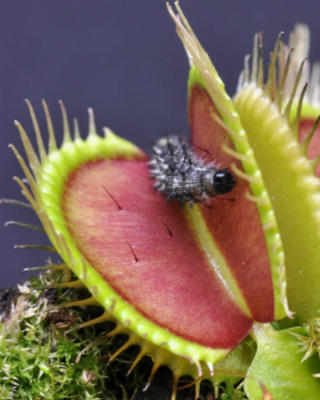Using AI to control energy for indoor agriculture
30 September 2024
Published online 14 May 2016
The molecular underpinnings of the Venus flytrap’s carnivorous lifestyle are illuminated in this new study.

© Sönke Scherzer
Now, scientists from Germany and Saudi Arabia have published the most detailed study1 yet of the molecular adaptation trends in play when Dionaea muscipula captures and consumes its meal – consequently, shedding more light on plant carnivory.
The Venus flytrap has similar morphological and physiological properties to a green plant. However, the predatory plant species has evolved a highly specialized trap for hunting animals.
It works as follows: The bi-lobed leaf functions as a snap trap, with the inner trap surface equipped with touch-sensitive hairs that translate mechanical stimulation into an electrical signal known as an action potential (AP).
Each touch generates an AP that the plant “memorizes”.
When the sensory hairs are touched once, the trap is set to attention mode. The second touch snaps the trap shut, locking the prey. The predator plant will then secrete specific digestive juices to devour its prey.
The Venus flytrap can count the numbers of AP generated, memorizing how often an insect has touched it, in turn preventing false alarms that would otherwise force it to slam its trap shut prematurely.
Scrutinizing its hunting strategy, the scientists have found out that, during evolution, the plant has reprogrammed defence systems, typically associated with herbivore plants, to eat flesh.
“There are no carnivory-specific’ genes or transcripts,” author Rainer Hedrich from the University of Würzburg tells Nature Middle East. “But Dionaea has rewired the underlying pathways to turn pathogen defense into offense. It's a very smart way to ‘recycle’ existing resources.”
Herbivore plants normally produce a stress hormone called Jasmonic acid (JA) when they’re wounded, but the Venus flytrap has evolved to use JA differently; upregulating it through its insect-stimulated trap instead. The mechanism converts the number of APs into a chemical signal that roughly informs the Venus flytrap of the size and nutrient content of its prey.
The plant has also used another defense system that recognizes invaders to its benefit – contact with chitin.
“Contact with chitin normally means danger for a plant – that insects will eat the plant,” says Hedrich.
Chitin is typically found in insect exoskeletons. But the Venus flytrap has evolved to detect contact with chitin and in turn the chemical composition of its prey, so it can regulate the production of digestive enzymes based on this information.
For instance, contact with chitin now turns on genes that cause the flytrap to produce extra chitin-digesting enzymes.
In their study, the scientists generated genome-wide transcription profiles of traps before and during feeding, comparing these to other plant tissues. Their findings confirm the common assumption that traps are modified leaves. In fact, in its resting state, the trap functions as a normal leaf; a photosynthetic organ of the plant.
The glands that promote insect digestion, however, resemble roots in their gene expression pattern.
“Dionaea has adopted a root-like machinery for some of the leaf cells,” says Hedrich. That means that the way roots are involved in nutrient uptake from the soil is similar to how the flytrap absorbs prey-derived nutrients; both are guided by the same genetic programme.
“Carnivory was very likely not newly invented by plants,” conclude the scientists, “but a result of smart enhancements of preexisting pathways.”
They used proteomic screening to assess the flytrap’s digestive fluid, and electron microcopy to study the fine structure of the trap’s glands.
“In future studies, we ultimately want to know what equipment a plant needs to eat and live off animals,” says Hedrich.
doi:10.1038/nmiddleeast.2016.60
Stay connected: